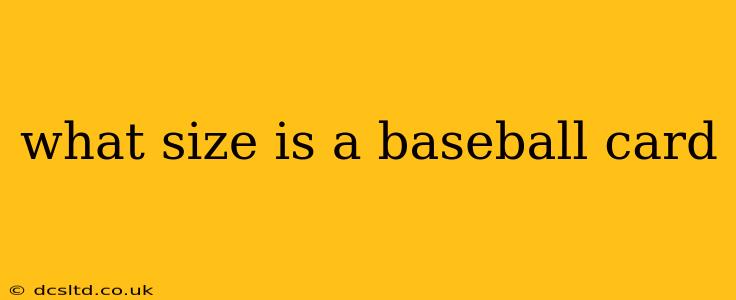What Size Is a Baseball Card? The Definitive Guide to Dimensions and Variations
Baseball cards are more than just pieces of cardboard; they're miniature slices of history, encapsulating moments of sporting glory and player legacies. But just how big are these iconic collectibles? While the standard size is generally consistent, there are some variations to keep in mind.
This guide will delve into the typical dimensions of baseball cards, explore historical variations, and answer some frequently asked questions about their sizing.
What are the standard dimensions of a baseball card?
The standard size for a modern baseball card is approximately 2.5 inches wide by 3.5 inches tall. This is the size you'll find for the vast majority of cards produced by Topps, Upper Deck, Panini, and other major manufacturers. These dimensions are largely consistent across different sets and years, providing a sense of uniformity and collectibility.
Are there different sizes of baseball cards?
While the 2.5" x 3.5" size is the dominant standard, there have been deviations throughout the history of baseball cards. Early cards, particularly those from the late 19th and early 20th centuries, often varied significantly in size and shape. You'll find examples considerably larger or smaller than the modern standard.
Furthermore, some modern manufacturers occasionally release cards in non-standard sizes, such as oversized cards, mini cards, or cards with unique shapes as part of promotional inserts or special sets. These are often clearly identified as exceptions to the rule.
How do I measure a baseball card?
The simplest way to measure a baseball card is using a standard ruler. Line up the edge of the ruler with one side of the card and note the measurement. Repeat this process for the other dimension. While slight variations might occur due to manufacturing tolerances, any significant deviation from the 2.5" x 3.5" standard likely points to a non-standard card.
What are the dimensions of vintage baseball cards?
Vintage baseball cards are notorious for variations in size. There's no single answer, as the dimensions depend heavily on the manufacturer and the year of production. Some sets might have cards slightly larger or smaller than the modern standard, while others may exhibit even more significant variations. Collectors often consult resources like online databases and card catalogs to identify the typical size ranges for specific sets.
Why is the standard size 2.5" x 3.5"?
The reasons behind the standardization to 2.5" x 3.5" are not definitively documented. However, it's likely a combination of factors, including efficient production, ease of storage, and consumer expectations. This size provides a good balance between showcasing player images and being compact enough for convenient collection and storage.
Are there any other variations I should be aware of?
Besides size, variations in card thickness can also occur. Some cards might be thicker due to the use of different card stock or the inclusion of extra inserts. Be aware of these variations when storing and handling your collection. Proper storage methods can help protect your cards from damage and maintain their value.
By understanding the standard dimensions and potential variations, you can better appreciate the nuances of your baseball card collection. Remember, careful examination and research can reveal fascinating insights into the history and production of these collectibles.
